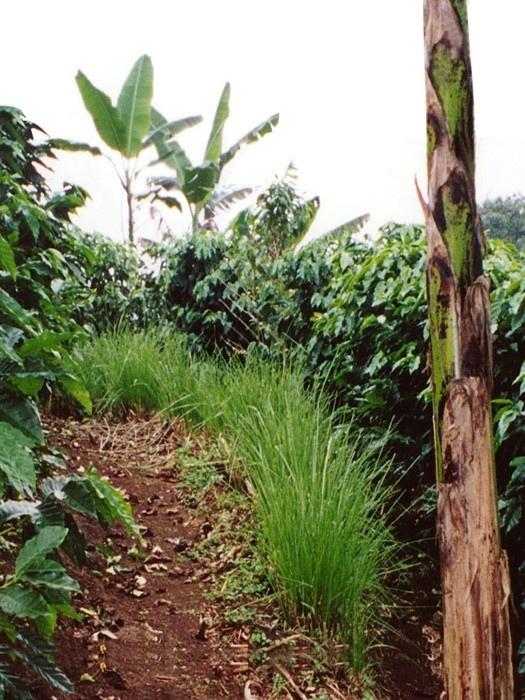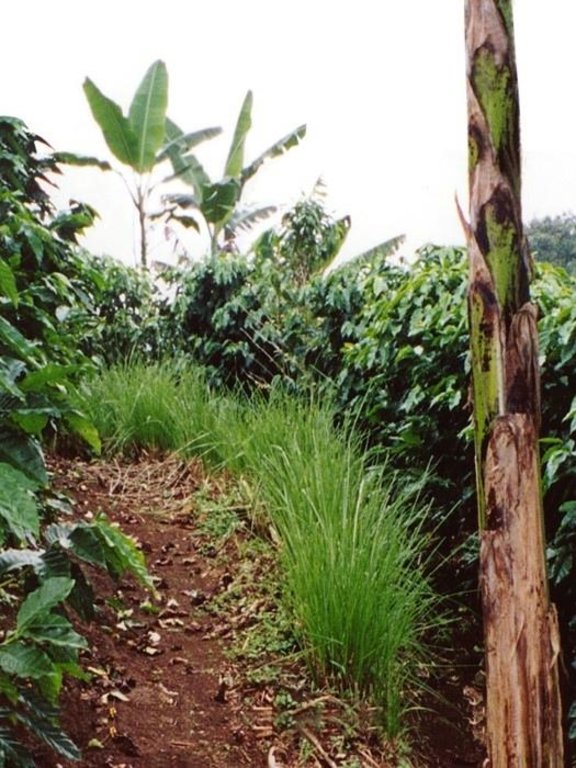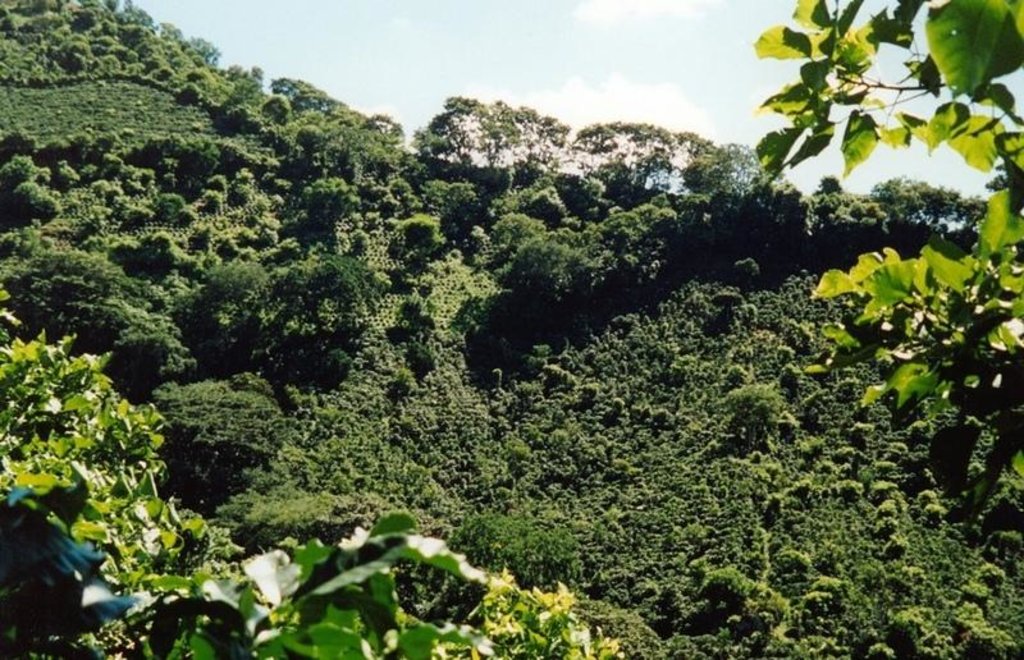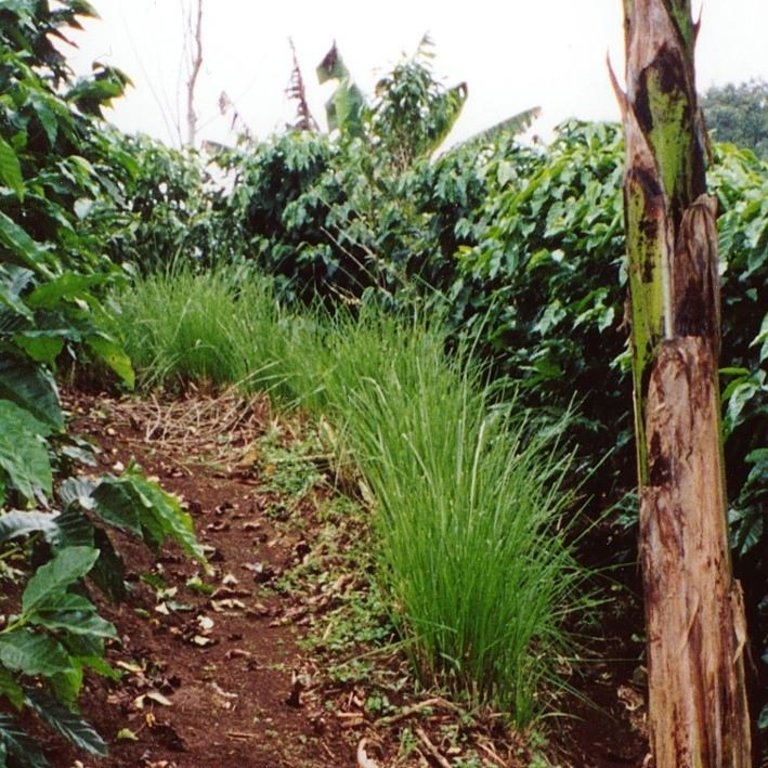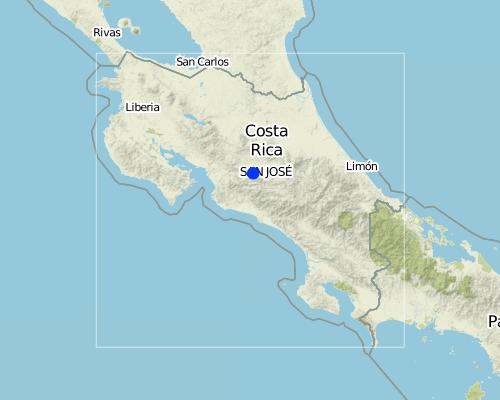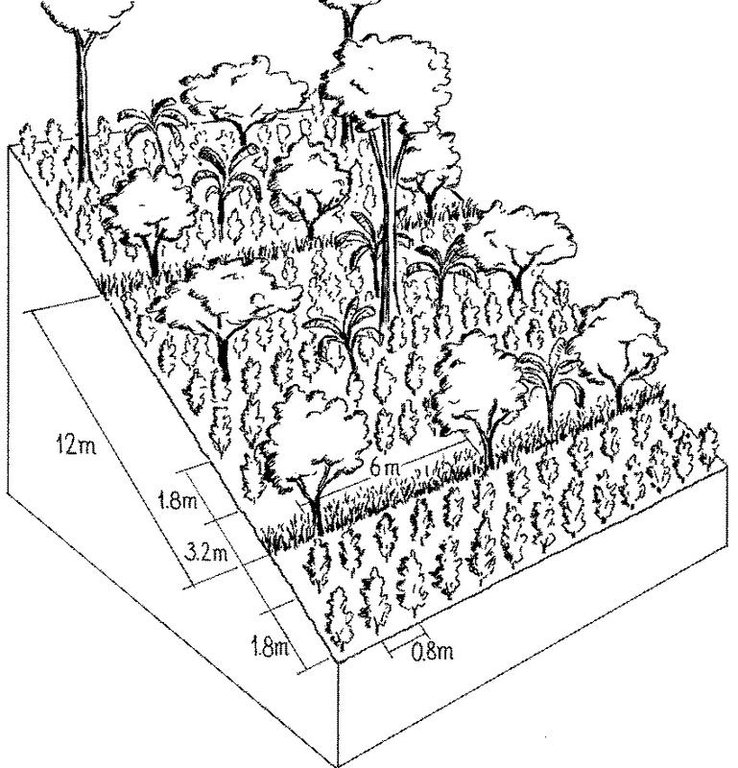Shade-grown coffee [คอสตาริกา]
- ผู้สร้างสรรค์:
- การอัพเดท:
- ผู้รวบรวม: Olman Quiros Madrigal
- ผู้เรียบเรียง: –
- ผู้ตรวจสอบ: Deborah Niggli
Café arbolado (spanish)
technologies_1044 - คอสตาริกา
ดูส่วนย่อย
ขยายทั้งหมด ย่อทั้งหมด1. ข้อมูลทั่วไป
1.2 รายละเอียดที่ติดต่อได้ของผู้รวบรวมและองค์กรที่เกี่ยวข้องในการประเมินและการจัดเตรียมทำเอกสารของเทคโนโลยี
1.3 เงื่อนไขการใช้ข้อมูลที่ได้บันทึกผ่านทาง WOCAT
วันที่เก็บรวบรวมข้อมูล(ภาคสนาม) :
01/08/2001
ผู้รวบรวมและวิทยากรหลักยอมรับเงื่อนไขเกี่ยวกับการใช้ข้อมูลที่ถูกบันทึกผ่านทาง WOCAT:
ใช่
1.4 การเปิดเผยเรื่องความยั่งยืนของเทคโนโลยีที่ได้อธิบายไว้
เทคโนโลยีที่ได้อธิบายไว้นี้เป็นปัญหาของความเสื่อมโทรมโทรมของที่ดินหรือไม่ จึงไม่ได้รับการยอมรับว่าเป็นเทคโนโลยีเพื่อการจัดการที่ดินอย่างยั่งยืน:
ไม่ใช่
2. การอธิบายลักษณะของเทคโนโลยี SLM
2.1 การอธิบายแบบสั้น ๆ ของเทคโนโลยี
คำจำกัดความของเทคโนโลยี:
An agroforestry system which combines coffee with shade trees - including fruit, timber and leguminous species - in a systematic fashion.
2.2 การอธิบายแบบละเอียดของเทคโนโลยี
คำอธิบาย:
Shade-grown coffee is a traditional and complex agroforestry system where coffee is associated with various other species in different storeys (or ‘levels’). This provides ecologically and economically sustainable use of natural resources. Café arbolado, the example promoted by PRODAF (Programme for Agroforestry Development, see related approach: ‘Agroforestry Extension’) since 1987 is one technical option for shade-grown coffee.
While based on a traditional system the shade-grown coffee technology has a specific layout, and a reduced number of intercropped species. It comprises: (1) Coffee (Coffea arabica) planted on the contour at approximately 5,000 plants per hectare; (2) Associated trees: fruits, most commonly oranges (120 trees/ha), cedar (Cedrela odorata) or caoba (Swietenia macrophylla) for timber (60 trees/ha) and also two legumes, poró (Erythrina poeppigiana) and chalum (Inga sp.) which act as shade trees and at the same time improve the soil by fixing nitrogen (60 trees/ha). Farmers often include bananas in the system. In some cases, orange trees have partly been substituted by avocado (Persea americana), soursop (Anona muricata), and/or jocotes (Spondias purpurea). The latter two command good market prices and do not compete with labour needed for harvesting and other activities; (3) Supportive soil conservation measures on steep slopes to avoid soil erosion, predominantly strips of lemon grass (Cymbopogon citratus) on the contour, retention ditches and soil cover improvement; (4) Fertilizers: both organic and inorganic combined.
Full establishment of a shaded coffee plot can be achieved in two years - after replanting trees which fail to establish. Coffee yields a harvest after two years, but timber from associated trees can be expected after only 25 years. The trees grown in association allow more efficient cycling of nutrients (because of deep rooting and nitrogen fixation) and provide a favourable microclimate for coffee. This production system is well adapted to the local biophysical and socio-economic conditions, characterised by steep erosion-prone mountain slopes, humid climate and small to medium scale agriculture. Based on café arbolado a new, and further developed system of ‘sustainable coffee’ has evolved. This involves certification of the overall process and is attractive to the growing number of environmentally conscious consumers.
2.3 รูปภาพของเทคโนโลยี
2.5 ประเทศภูมิภาค หรือสถานที่ตั้งที่เทคโนโลยีได้นำไปใช้และได้รับการครอบคลุมโดยการประเมินนี้
ประเทศ:
คอสตาริกา
ภูมิภาค/รัฐ/จังหวัด:
San José/Río Parrita
ข้อมูลจำเพาะเพิ่มเติมของสถานที่ตั้ง :
Acosta-Puriscal
Map
×2.7 คำแนะนำของเทคโนโลยี
ให้ระบุว่าเทคโนโลยีถูกแนะนำเข้ามาอย่างไร:
- ทางโครงการหรือจากภายนอก
3. การจัดประเภทของเทคโนโลยี SLM
3.1 วัตถุประสงค์หลักของเทคโนโลยี
- ปรับปรุงการผลิตให้ดีขึ้น
- ลด ป้องกัน ฟื้นฟู การเสื่อมโทรมของที่ดิน
3.2 ประเภทของการใช้ที่ดินในปัจจุบันที่ได้นำเทคโนโลยีไปใช้

การใช้ที่ดินแบบผสมผสาน (รวมถึงวนเกษตร)
- วนเกษตร (Agroforestry)
แสดงความคิดเห็น:
Major land use problems (compiler’s opinion): Severe deforestation, inappropriate land management practices (monocultures on steep slopes; lack of conservation measures); resulting in physical (soil erosion) and chemical (fertility decline) degradation of agricultural soils, low productivity and low yields.
3.3 ข้อมูลเพิ่มเติมเกี่ยวกับการใช้ที่ดิน
การใช้น้ำของที่ดินที่มีการใช้เทคโนโลยีอยู่:
- จากน้ำฝน
ระบุ:
Longest growing period in days: 270, Longest growing period from month to month: Apr - Dec
3.4 กลุ่ม SLM ที่ตรงกับเทคโนโลยีนี้
- การปลูกป่าร่วมกับพืช
3.5 กระจายตัวของเทคโนโลยี
แสดงความคิดเห็น:
Total area covered by the SLM Technology is 400 m2.
3.6 มาตรการ SLM ที่ประกอบกันเป็นเทคโนโลยี

มาตรการจัดการพืช
- A1: พืช/สิ่งปกคลุมดิน

มาตรการอนุรักษ์ด้วยวิธีพืช
- V1: ต้นไม้และพุ่มไม้คลุมดิน
- V2: หญ้าและไม้ยืนต้น
แสดงความคิดเห็น:
Type of agronomic measures: mixed cropping / intercropping
Type of vegetative measures: aligned: -contour
3.7 รูปแบบหลักของการเสื่อมโทรมของที่ดินที่ได้รับการแก้ไขโดยเทคโนโลยี

การกัดกร่อนของดินโดยน้ำ
- Wt (Loss of topsoil): การสูญเสียดินชั้นบนหรือการกัดกร่อนที่ผิวดิน
- Wm (Mass movement): การเคลื่อนตัวของมวลดินหรือดินถล่ม

การเสื่อมโทรมของดินทางด้านเคมี
- Cn (Fertility decline): ความอุดมสมบูรณ์และปริมาณอินทรียวัตถุในดินถูกทำให้ลดลงไป (ไม่ได้เกิดจากสาเหตุการกัดกร่อน)
แสดงความคิดเห็น:
Main causes of degradation: deforestation / removal of natural vegetation (incl. forest fires), over-exploitation of vegetation for domestic use, overgrazing, education, access to knowledge and support services (Falta de conocimientos), Falta de tecnología
Secondary causes of degradation: poverty / wealth (Falta de capital), Falta de fortaleza de legislación / de autoridad
3.8 การป้องกัน การลดลง หรือการฟื้นฟูความเสื่อมโทรมของที่ดิน
ระบุเป้าหมายของเทคโนโลยีกับความเสื่อมโทรมของที่ดิน:
- ป้องกันความเสื่อมโทรมของที่ดิน
4. ข้อมูลจำเพาะด้านเทคนิค กิจกรรมการนำไปปฏิบัติใช้ ปัจจัยนำเข้า และค่าใช้จ่าย
4.1 แบบแปลนทางเทคนิคของเทคโนโลยี
4.2 ข้อมูลจำเพาะด้านเทคนิคและการอธิบายแบบแปลนทางเทคนิค
Example layout of coffee grown below shade trees: various species are used for shade, and each has intrinsic value of its own - orange trees (for fruit) are associated with strips of lemon grass, tall cedars (for timber) are planted in rows alternating with Erythrina sp. (for fertility improvement). Optionally, banana trees are interplanted.
Technical knowledge required for field staff / advisors: high
Technical knowledge required for land users: high
Main technical functions: improvement of ground cover, increase in organic matter, increase of infiltration, increase in soil fertility
Secondary technical functions: control of raindrop splash, control of concentrated runoff, control of dispersed runoff
Agronomic measure: organic/chem. Fertilization
Aligned: -contour
Vegetative material: T : trees / shrubs
Number of plants per (ha): 60-120
Spacing between rows / strips / blocks (m): 12
Width within rows / strips / blocks (m): 6
Vegetative measure: grass strips
Vegetative material: G : grass
Spacing between rows / strips / blocks (m): 12
Vegetative measure: aligned shrubs
Vegetative material: G : grass
Number of plants per (ha): 5000
Spacing between rows / strips / blocks (m): 1.8
Width within rows / strips / blocks (m): 0.8
Vegetative measure: Vegetative material: G : grass
Trees/ shrubs species: poró (Erythrina poeppigiana), chalum (Inga spp.)
Fruit trees / shrubs species: Coffee, oranges, cedar or caoba for timber, bananas, oranges or avocado, soursop , and/or jocotes
Grass species: lemon grass (Cymbopogon citratus)
Structural measure: retention ditches (supp.)
4.4 กิจกรรมเพื่อการจัดตั้ง
| กิจกรรม | ประเภทของมาตรการ | ช่วงเวลาดำเนินการ | |
|---|---|---|---|
| 1. | Clearing of land. | ด้วยวิธีพืช | beginning of rainy season (March/April) |
| 2. | Surveying for contour planting of coffee, grass strips, trees etc. | ด้วยวิธีพืช | beginning of rainy season (March/April) |
| 3. | Digging holes, fertilizer application. | ด้วยวิธีพืช | beginning of rainy season (March/April) |
| 4. | Planting coffee, trees, grass barriers etc along the contour. | ด้วยวิธีพืช | beginning of rainy season (March/April) |
| 5. | Replanting coffee that fails to establish in first year. | ด้วยวิธีพืช | beginning of rainy season (March/April) |
4.5 ค่าใช้จ่ายของปัจจัยนำเข้าที่จำเป็นสำหรับการจัดตั้ง
| ปัจจัยนำเข้า | หน่วย | ปริมาณ | ค่าใช้จ่ายต่อหน่วย | ค่าใช้จ่ายทั้งหมดต่อปัจจัยนำเข้า | %ของค่าใช้จ่ายที่ก่อให้เกิดขึ้นโดยผู้ใช้ที่ดิน | |
|---|---|---|---|---|---|---|
| แรงงาน | labour | ha | 1.0 | 700.0 | 700.0 | 100.0 |
| วัสดุด้านพืช | Seedlings: poró/cedar | ha | 1.0 | 15.0 | 15.0 | |
| วัสดุด้านพืช | Seedlings: orange trees | ha | 1.0 | 220.0 | 220.0 | |
| วัสดุด้านพืช | Seedlings: coffee | ha | 1.0 | 1240.0 | 1240.0 | |
| ปุ๋ยและสารฆ่า/ยับยั้งการเจริญเติบโตของสิ่งมีชีวิต (ไบโอไซด์) | fertilizer | ha | 1.0 | 350.0 | 350.0 | |
| อื่น ๆ | transport | ha | 1.0 | 10.0 | 10.0 | |
| ค่าใช้จ่ายทั้งหมดของการจัดตั้งเทคโนโลยี | 2535.0 | |||||
แสดงความคิดเห็น:
Duration of establishment phase: 24 month(s)
4.6 การบำรุงรักษาสภาพหรือกิจกรรมที่เกิดขึ้นเป็นประจำ
| กิจกรรม | ประเภทของมาตรการ | ช่วงระยะเวลา/ความถี่ | |
|---|---|---|---|
| 1. | Fertilization | จัดการพืช | May, July, November / 1–3 times |
| 2. | Pest control (spraying) | จัดการพืช | May, September / 1–2 times |
| 3. | Application of lime. | จัดการพืช | |
| 4. | Pest control (spraying) | จัดการพืช | May, September / 1–2 times |
| 5. | Application of lime. | จัดการพืช | |
| 6. | Weed control | ด้วยวิธีพืช | Weed control |
| 7. | Pruning coffee | ด้วยวิธีพืช | February or March / |
| 8. | Pruning shade trees. | ด้วยวิธีพืช |
4.7 ค่าใช้จ่ายของปัจจัยนำเข้าและกิจกรรมที่เกิดขึ้นเป็นประจำที่ต้องการการบำรุงรักษา (ต่อปี)
| ปัจจัยนำเข้า | หน่วย | ปริมาณ | ค่าใช้จ่ายต่อหน่วย | ค่าใช้จ่ายทั้งหมดต่อปัจจัยนำเข้า | %ของค่าใช้จ่ายที่ก่อให้เกิดขึ้นโดยผู้ใช้ที่ดิน | |
|---|---|---|---|---|---|---|
| แรงงาน | labour | ha | 1.0 | 28.0 | 28.0 | 100.0 |
| ปุ๋ยและสารฆ่า/ยับยั้งการเจริญเติบโตของสิ่งมีชีวิต (ไบโอไซด์) | fertilizer | ha | 1.0 | 175.0 | 175.0 | 100.0 |
| อื่น ๆ | transport | ha | 1.0 | 127.0 | 127.0 | 100.0 |
| ค่าใช้จ่ายทั้งหมดของการบำรุงรักษาสภาพเทคโนโลยี | 330.0 | |||||
แสดงความคิดเห็น:
Machinery/ tools: shovel, machete, knapsack
The costs of planting coffee are included. Shade-grown coffee is an integrated production system, and thus costs for coffee and the agroforestry component cannot be disaggregated.
5. สิ่งแวดล้อมทางธรรมชาติและของมนุษย์
5.1 ภูมิอากาศ
ฝนประจำปี
- < 250 ม.ม.
- 251-500 ม.ม.
- 501-750 ม.ม.
- 751-1,000 ม.ม.
- 1,001-1,500 ม.ม.
- 1,501-2,000 ม.ม.
- 2,001-3,000 ม.ม.
- 3,001-4,000 ม.ม.
- > 4,000 ม.ม.
เขตภูมิอากาศเกษตร
- ชื้น
Thermal climate class: tropics
5.2 สภาพภูมิประเทศ
ค่าเฉลี่ยความลาดชัน:
- ราบเรียบ (0-2%)
- ลาดที่ไม่ชัน (3-5%)
- ปานกลาง (6-10%)
- เป็นลูกคลื่น (11-15%)
- เป็นเนิน (16-30%)
- ชัน (31-60%)
- ชันมาก (>60%)
ธรณีสัณฐาน:
- ที่ราบสูง/ที่ราบ
- สันเขา
- ไหล่เขา
- ไหล่เนินเขา
- ตีนเนิน
- หุบเขา
ระดับความสูง:
- 0-100 เมตร
- 101-500 เมตร
- 501-1,000 เมตร
- 1,001-1,500 เมตร
- 1,501-2,000 เมตร
- 2,001-2,500 เมตร
- 2,501-3,000 เมตร
- 3,001-4,000 เมตร
- > 4,000 เมตร
5.3 ดิน
ค่าเฉลี่ยความลึกของดิน:
- ตื้นมาก (0-20 ซ.ม.)
- ตื้น (21-50 ซ.ม.)
- ลึกปานกลาง (51-80 ซ.ม.)
- ลึก (81-120 ซ.ม.)
- ลึกมาก (>120 ซ.ม.)
เนื้อดิน (ดินชั้นบน):
- ปานกลาง (ดินร่วน ทรายแป้ง)
- ละเอียด/หนัก (ดินเหนียว)
อินทรียวัตถุในดิน:
- สูง (>3%)
- ปานกลาง (1-3%)
5.6 ลักษณะของผู้ใช้ที่ดินที่นำเทคโนโลยีไปปฏิบัติใช้
แนวทางการตลาดของระบบการผลิต:
- ผสม (การเลี้ยงชีพ/ทำการค้า)
รายได้ที่มาจากนอกฟาร์ม:
- 10-50% ของรายได้ทั้งหมด
ระดับของการใช้เครื่องจักรกล:
- งานที่ใช้แรงกาย
ระบุลักษณะอื่นๆที่เกี่ยวข้องของผู้ใช้ที่ดิน:
Off-farm income specification: subdivision of land (through inheritance), improved communications linking the capital with rural areas, and a better system of education all provide for increased off-farm income earning opportunities
5.7 พื้นที่เฉลี่ยของที่ดินที่เป็นเจ้าของหรือเช่าโดยผู้ใช้ที่ดินที่นำเทคโนโลยีไปปฏิบัติใช้
- < 0.5 เฮกตาร์
- 0.5-1 เฮกตาร์
- 1-2 เฮกตาร์
- 2-5 เฮกตาร์
- 5-15 เฮกตาร์
- 15-50 เฮกตาร์
- 50-100 เฮกตาร์
- 100-500 เฮกตาร์
- 500-1,000 เฮกตาร์
- 1,000-10,000 เฮกตาร์
- >10,000 เฮกตาร์
5.8 กรรมสิทธิ์ในที่ดิน สิทธิในการใช้ที่ดินและสิทธิในการใช้น้ำ
กรรมสิทธิ์ในที่ดิน:
- รายบุคคล ไม่ได้รับสิทธิครอบครอง
- รายบุคคล ได้รับสิทธิครอบครอง
สิทธิในการใช้ที่ดิน:
- รายบุคคล
6. ผลกระทบและสรุปคำบอกกล่าว
6.1 ผลกระทบในพื้นที่ดำเนินการ (On-site) จากการใช้เทคโนโลยี
ผลกระทบทางด้านเศรษฐกิจและสังคม
การผลิต
การผลิตพืชผล
แสดงความคิดเห็น/ระบุ:
coffee, about 10% less than in conventional systems (per ha per year)
การผลิตไม้
รายได้และค่าใช้จ่าย
ภาระงาน
ผลกระทบด้านสังคมวัฒนธรรมอื่น ๆ
สถาบันแห่งชาติ
ผลกระทบด้านนิเวศวิทยา
ดิน
ความชื้นในดิน
สิ่งปกคลุมดิน
การสูญเสียดิน
ลดความเสี่ยงของภัยพิบัติ
ความเร็วของลม
6.2 ผลกระทบนอกพื้นที่ดำเนินการ (Off-site) จากการใช้เทคโนโลยี
น้ำท่วมพื้นที่ท้ายน้ำ
6.4 การวิเคราะห์ค่าใช้จ่ายและผลประโยชน์ที่ได้รับ
ผลประโยชน์ที่ได้รับเปรียบเทียบกับค่าใช้จ่ายในการจัดตั้งเป็นอย่างไร (จากมุมมองของผู้ใช้ที่ดิน)
ผลตอบแทนระยะสั้น:
ด้านลบ
ผลตอบแทนระยะยาว:
ด้านบวก
ผลประโยชน์ที่ได้รับเปรียบเทียบกับค่าใช้จ่ายในการบำรุงรักษาหรือต้นทุนที่เกิดขึ้นซ้ำอีก เป็นอย่างไร (จากมุมมองของผู้ใช้ที่ดิน)
ผลตอบแทนระยะสั้น:
ด้านบวก
ผลตอบแทนระยะยาว:
ด้านบวกอย่างมาก
6.5 การปรับตัวของเทคโนโลยี
แสดงความคิดเห็น:
100% of land user families have adopted the Technology with external material support
There is a little trend towards spontaneous adoption of the Technology. There is a slight trend towards growing spontaneous adoption - after the end of the programme. However, the crisis triggered by the big drop in coffee prices has had a negative impact on adoption of the technology. Many coffee farms have been abandoned specially those located under 800-900 m a.s.l. where coffee is of a lower quality due to climatic conditions.
6.7 จุดแข็ง / ข้อได้เปรียบ / โอกาสของเทคโนโลยี
| จุดแข็ง / ข้อได้เปรียบ / โอกาสในทัศนคติของผู้รวบรวมหรือวิทยากรหลัก |
|---|
| Increased overall crop production and diversity: coffee, fruit, timber, legumes |
| Different crops harvested at different periods, gives better distribution of labour (and income) throughout the year; participation of all family members; increased food security and minimal economic risk |
| Improved profitability. |
| More efficient use of nutrients, nitrogen fixation, lower inputs of fertilizers. |
| Increased pest resistance, lower external inputs of biocides. Coffe plants continue to produce over 25 years due to optimal microclimate (only 15 years in conventional system without trees). Production system adapted to steep erosion prone slopes, thus a productive alternative to simple afforestation. Not labour-intensive compared with structural measures of SWC. High commercial potential of environmentally friendly produced coffee due to new market trends. Price increase for agricultural inputs has favoured a shift from conventional to shade-grown coffee, the latter being a system with a higher ratio of applied inputs/harvested yields although total production is usually lower than in modern coffee plantations. |
6.8 จุดอ่อน / ข้อเสียเปรียบ / ความเสี่ยงของเทคโนโลยีและวิธีการแก้ไข
| จุดอ่อน / ข้อเสียเปรียบ / ความเสี่ยงในทัศนคติของผู้รวบรวมหรือวิทยากรหลัก | มีวิธีการแก้ไขได้อย่างไร |
|---|---|
| Slight decrease in production of coffee per hectare compared to the conventional pure stand | Compensate by additional benefits: wood production, fruit, etc. |
| Short-term negative cost-benefit ratio in the first 4–5 years: Costintensive technology in the establishment phase. | Identify fast growing species or species providing intermediate products. |
| Timber harvest only in the long term (after 25 years) |
7. การอ้างอิงและการเชื่อมต่อ
7.1 วิธีการและแหล่งข้อมูล
- ไปเยี่ยมชมภาคสนาม การสำรวจพื้นที่ภาคสนาม
- การสัมภาษณ์กับผู้ใช้ที่ดิน
7.2 การอ้างอิงถึงสิ่งตีพิมพ์
หัวข้อ, ผู้เขียน, ปี, หมายเลข ISBN:
PRODAF . Sistema agroforestal – Café arbolado, Ecología y economía para el progreso, Puriscal, Costa Rica. 1994.
หัวข้อ, ผู้เขียน, ปี, หมายเลข ISBN:
Neuenschwander E . Agorforstwirtschaftlicher Kaffeeanbau als Lösungsansatz für eine ökologisch nachhaltige Bodennutzung der Hanglagen inCosta Rica: eine Fallstudie im Rahmen des WOCAT Programms, unpublished MSc thesis. 2002.
ชื่อเรื่อง ผู้เขียน ปี ISBN:
Science Faculty, University of Berne, Centre for Developmentand Environment
ลิงก์และโมดูล
ขยายทั้งหมด ย่อทั้งหมดลิงก์
ไม่มีลิงก์
โมดูล
ไม่มีโมดูล


